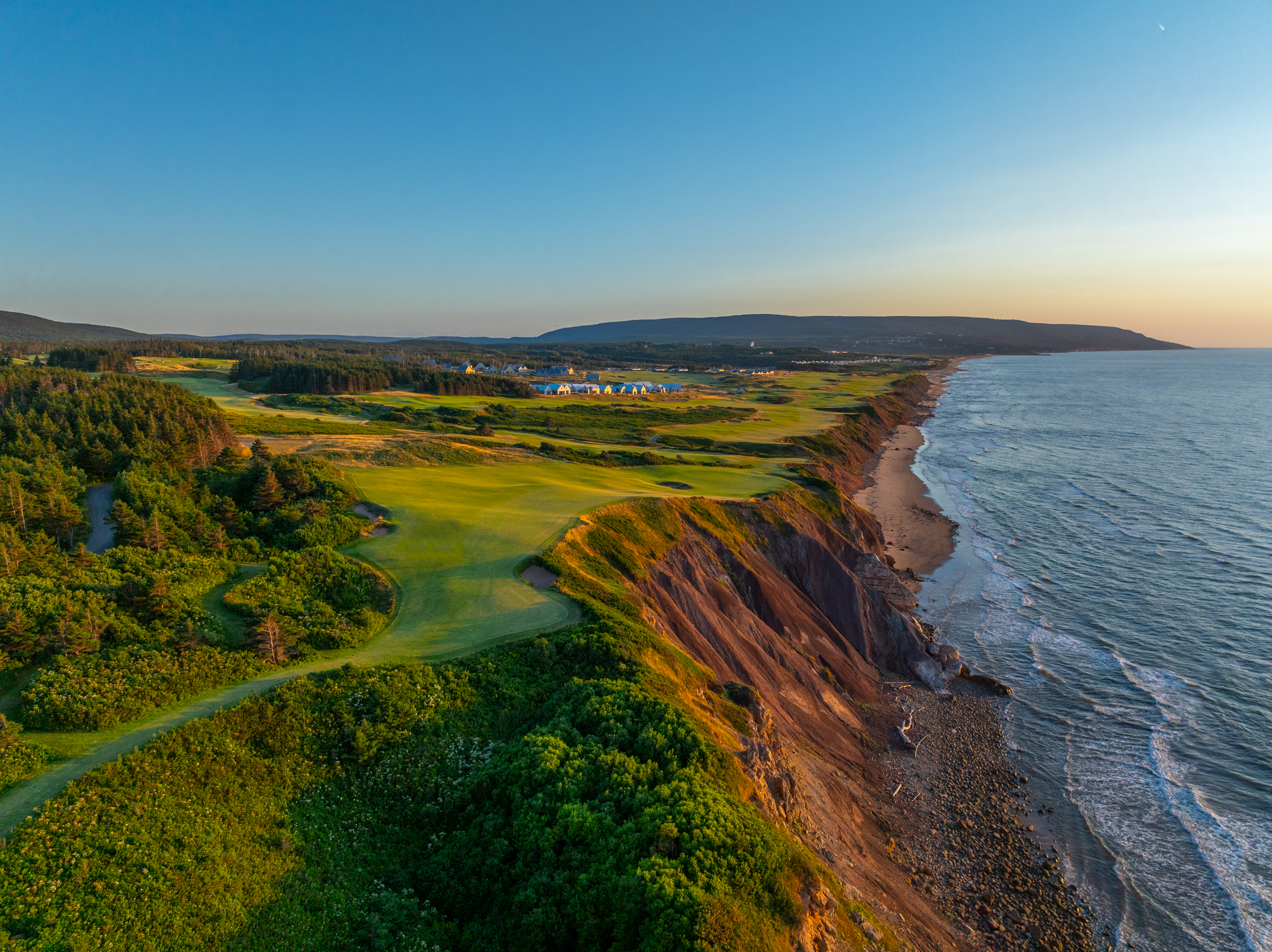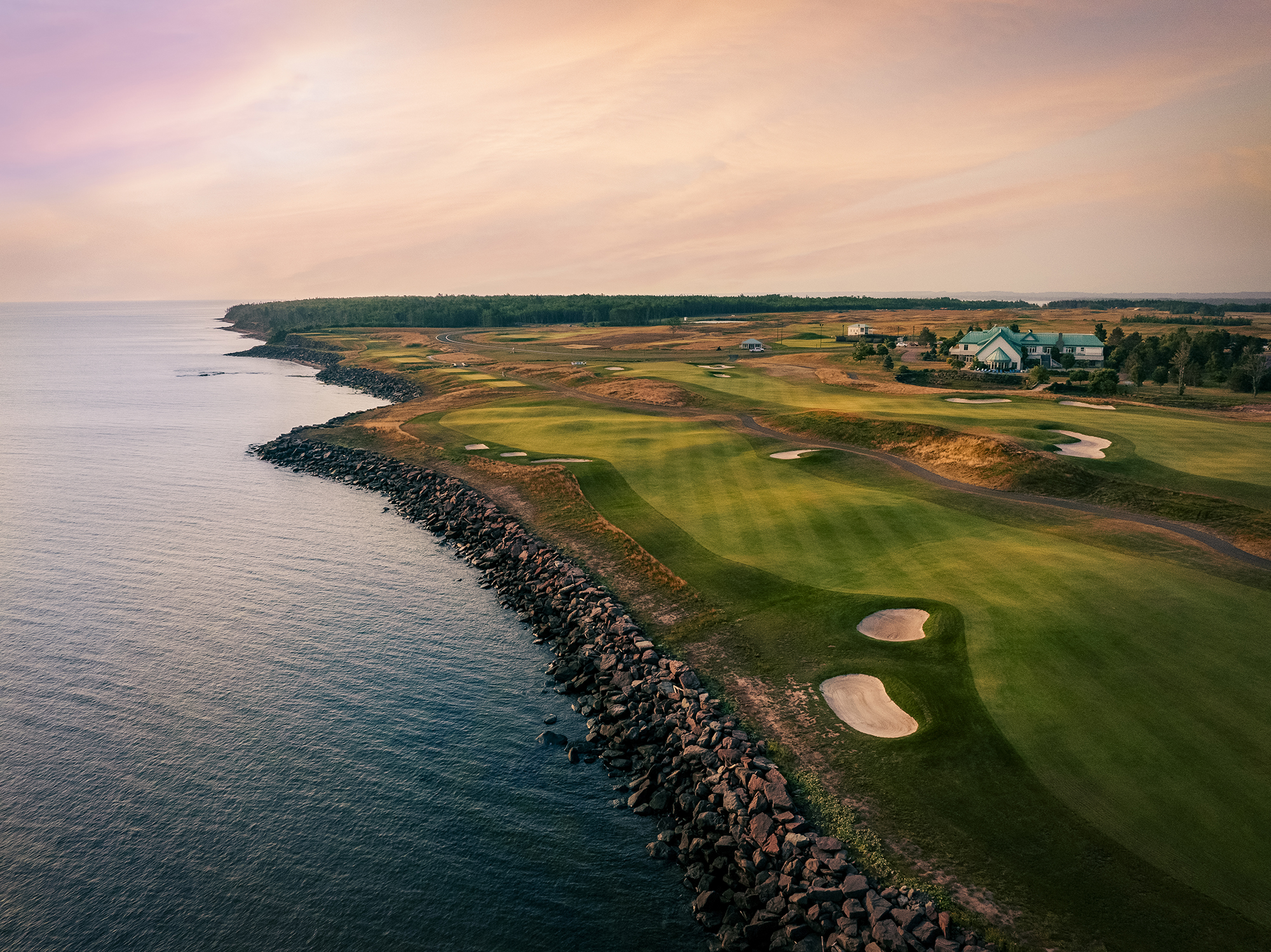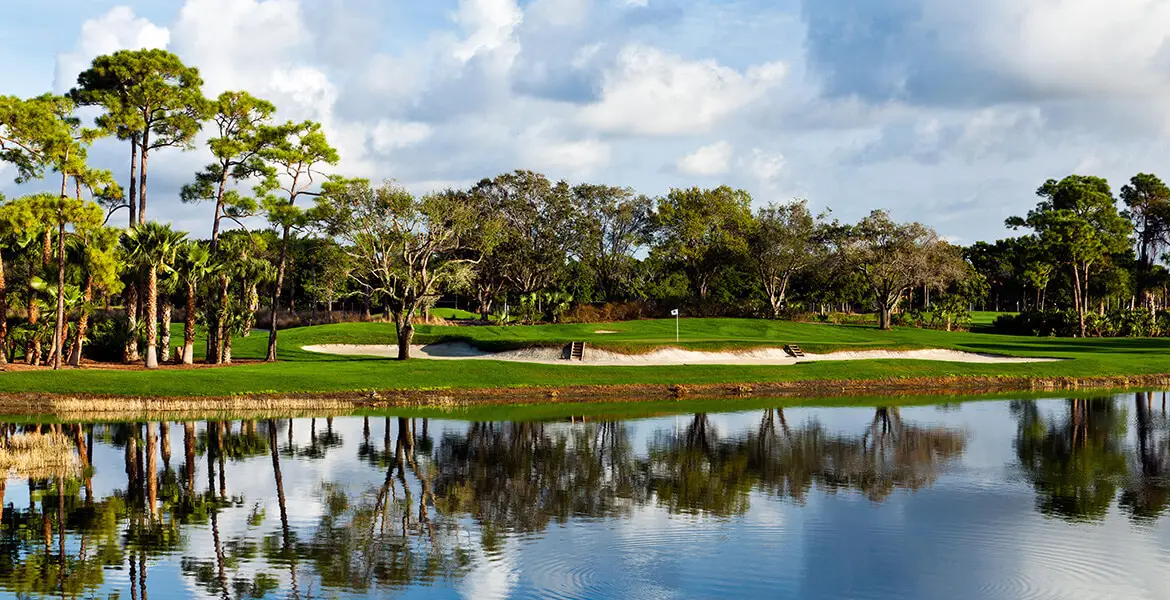If you’ve ever flown to Scotland from the East Coast, it’s likely you snoozed right over Nova Scotia—New Scotland—and didn’t give a passing thought to the bounty of golf riches that lay below you. But just like Scotland, Canada’s Ocean Playground has a diverse lineup of stellar public courses, along with natural beauty and unique off-course diversions that’ll have you looking at real estate listings. You can drive from one end of Nova Scotia to the other in less than seven hours, and you’re never more than forty miles from its coastline. So superb golf is always close at hand—along with stunning landscapes, historic sites, and seafood (particularly lobster and scallops) that’ll be fresher than anything you’ve ever tasted.
Here’s a list of the top public courses you should consider for your Nova Scotia golf adventure. They all have their own unique character, histories, and stories to tell. Each is surrounded by unspoiled nature on a grand scale. And you’ll be welcome with open arms wherever you go. After all, this is Canada, where the people are as uniformly nice as the summertime weather.
Cabot Links—Inverness
At Cabot Cape Breton in Inverness, two International Top 100 courses await you, as well as comfortable accommodations and a lively but laid-back resort atmosphere that’s ideal for any golf getaway. There’s a reason why the homes and homesites are selling so fast at the Cabot group’s flagship resort: no one ever wants to leave. And at that heart of that sentiment lie its golf courses.

Cabot Links opened first in 2012, and the world quickly took notice of the superb links layout that Canadian architect Rod Whitman had created there. Whitman provides players with plenty of room off the tees; you really must hit it crooked to find the tall fescue that frames its fairways. But you’d better find the right part of the fairway to take on the hole locations on this course’s large, often-elevated, and always-tilting greens. Miss your landing spot and you’re likely to have a perilously long putt (or chip shot).
The holes here are postcard-scenic and deceptively challenging. At the 6th, you play right along the shoreline of an achingly beautiful harbor from which fishermen may be onlookers. The short par-three 14th plays downhill to the sea and resembles the 7th at Pebble Beach. The long par-four 18th finishes within steps of the clubhouse, with its ready-made gallery of people enjoying the sunshine on the patio. A true links that plays firm and fast, it’s a beautiful course with all the humps and hollows and vagaries a links should have, and one that calls for strategic thinking and careful shot placement with every swing.
Cabot Cliffs—Inverness
A few minutes up the road past the Inverness Miners Museum, Cabot Cape Breton’s second course awaits. Opened in 2015, Bill Coore and Ben Crenshaw did the design work here, and its clifftop setting is even more dramatic than its sibling’s; the sea is in view throughout your round, and the beach might even come into play if you hit it terribly crooked. Great holes abound as you climb hills, tack through stretches of wild grasses, pivot to avoid hairy-lipped bunkers, and do battle with very large greens exhibiting breaks that are sometimes subtle and often not. None are more memorable than the course’s pair of clifftop par threes: the 126-yard 9th, ringed by yawning bunkers with a steep falloff into the sea at the back, and the 176-yard 16th, where anything short, right, or long is in danger of missing the peninsula green and finding a watery grave.

Together with Cabot Links, it comprises Canada’s finest one-two punch. But don’t miss the resort’s 11-hole par-3 course—The Nest—whose tiny greens are diabolically clever and whose elevated setting is glorious, especially at sunset.
Cape Breton Highlands Links—Ingonish
Cape Breton Highlands Links, Nova Scotia’s other internationally acclaimed course, isn’t a bonafide links course. It’s hilly, with mature pines, oaks, and maples squeezing the lines of play just about everywhere. But it has many of the quirks of a links, including its out-and-back routing, and an unforgettable character all its own. Designed by Stanley Thompson, Canada’s Golden Age course-designer deity, it’s set smack within the Cape Breton Highlands National Park itself, making a round at Highlands Links a true nature expedition.
There’s not a flat fairway to be found—nor a flat lie. Anywhere. From the steeply uphill opening par four with its mogul-filled fairway to the rumpled, downhill-then uphill finishing hole, it’s a veritable roller coaster ride. And every hole culminates at greens and green sites whose shaping and contours should be studied in detail by anyone with an appreciation for creative golf architecture. Some of the fairways are so narrow as to be claustrophobic. All but the straightest hitters will lose a ball or two (or more). But you won’t care.
It’s exhilarating golf, with a great variety of holes, none of which (even the short par fours) is straightforward, as exhibited by the volcano green at the dogleg-right 4th hole. Though it’s close to the sea, there aren’t many ocean views. But you’ll get a glimpse of it at what many consider the course’s signature hole—the sinuous, downhill par-five 15th—which twists left then right, asks you to hit your second and third shots from madly tilting lies, and culminates at an elevated green that has three-putt written all over it. It’s a course worth crawling to. If time permits, play Antigonish Golf Club while you’re in the area. At 6,665 yards from the tips, it’s not a long course. But it offers great scenery and holes that will challenge the best of players.
Fox Harb’r Resort—Fox Harbour
The luxe Fox Harb’r Resort is in the County of Cumberland, where you’ll find yet more scenic coastline, with an almost unlimited number of coastal trails and charming small towns and harbors to explore. Created by local son Ron Joyce, co-founder of the Tim Horton’s chain of coffee and donut shops, Fox Harb’r offers five-star everything, from its luxury accommodations to the award-winning culinary offerings at its Cape Cliff restaurant, to the rejuvenating aromatherapy treatments at its oceanview Spa and Wellness Centre. But it’s golf that’s the main attraction, and that golf is in the process of getting a major upgrade.

The resort’s original course opened for play in 2001, but it’s undergoing a transformation right now at the skilled hands of Canadian architects Thomas McBroom and Doug Carrick. In May of 2025, their reimagined Ocean Nine opened to great acclaim. Nine new holes that play firm and fast await you there now, with tall fescue grasses framing the fairways and creative, angled greens that repel all but the best played shots and put pressure on your short game all day long. Two of these holes, a stirring par three and a shorefront par five reminiscent of the 18th at Pebble Beach, take you right to the edge of the Northumberland Strait.
When all the work is completed in the spring of 2027, Fox Harb’r will offer two 18-hole courses, the links-style Ocean Course and the new, neighboring Vineyard Course, a heathland-style design that’s routed inland amongst the property’s own vineyards, where its L’Acadie Blanc grapes produce truly exquisite champagne, white, and red wines. Don’t miss the chance to sample them after your round.
Northumberland Links—Pugwash
Just up the road from Fox Harb’r, Northumberland Links also sits directly on the Northumberland Strait. This is a locals’ course with an active membership that makes the most of the golf season, reminiscent of some of the busy local clubs in the UK and Ireland. Their course is a sporty one, with a mix of inland, tree-lined holes and others that are open, oceanfront, links-like testers. Be prepared for small greens, stiff breezes, and challenges aplenty, including at the 13th hole, the course’s signature hole, a do-or-die par three hard by the sea. Many a sea creature undoubtedly has a lost Titleist for neighbor in the waters near this green.
Digby Pines Golf Resort & Spa—Digby
The harbor town of Digby is located on the Bay of Fundy, which divides Nova Scotia from New Brunswick. The unique size and shape of the bay are responsible for it having the world’s highest tides. It’s like a gigantic bathtub in which the water is eternally sloshing back and forth, resulting in mind-boggling 50-foot tides that are a sight to behold. Dramatic rock formations line the bay’s shores, and from its waters come seafood that has rightfully made the region famous, including Digby scallops. Stanley Thompson undoubtedly enjoyed many of them when he was in the area in the late 1920s designing the course at the historic Digby Pines Golf Resort & Spa, a course that even today remains much as he left it. Thompson didn’t have armies of bulldozers at his disposal, so he worked with the lay of the land. During your round, you’ll encounter rolling hills and tumbling fairways with nary a flat lie to be found anywhere in its 6,300 yards. You’ll marvel at the imagination and skill Thompson put into the design of the holes, greens, and red-sand bunkers here, especially at holes like the downhill-over-water, par-three 2nd hole, where there’s a steeply sloped hill just right of the green and a water grave left. The difficult stretch from 12 to 15 is where the course really shows its teeth—but also its beauty. The downhill par-four 15th offers nice views of the bay but features a green that runs away from the fairway, making it tough to hold. At the finishing hole, an uphill par five, Thompson peppered the fairway with bunkers, making accuracy a must to come home with a par. The resort itself offers comfortable accommodations in its historic building and neighboring cottages, and the full-service spa and bay-view swimming pavilion are great places to visit before tucking into some Digby scallops of your own.
The Links at Brunello—Timberlea
The Links at Brunello is located just west of Halifax, provincial capital of Nova Scotia and most populous city in Atlantic Canada, where you’ll find a visually stunning Thomas McBroom design that winds through broad stands of tall pines, with deep white-sand bunkers, healthy rough, enough ponds and wetland areas to keep you vigilant, and large greens that beguile and befuddle. There’s a good amount of elevation change, too, with several challenging uphill and downhill shots along the way. The course tips out at almost 7,000 yards but has five sets of tees so it’s enjoyable by players of every stripe. The 156-yard par-three 10th hole is particularly memorable and photo-worthy, with rock outcroppings and a saddle green contributing significantly to the drama.
Chester Golf Club—Chester
With its wonderful location hard by the sea, Chester Golf Club has been thrilling Halifax-area players since the day it opened as a 9-holer in 1914. Now an 18-hole course from Canadian architect Les Furber, Chester is situated on the south shore of Chandlers Cove, where the views of the neighboring islands are gorgeous and the winds off the water are often a factor. Measuring a little over 6,000 yards from the tips, it’s not a championship course. But there are challenges galore, as at the short par-three 8th with its tilting green, and the skinny double-dogleg 15th—a par five where accuracy is required from tee to elevated (and well-bunkered) green.
The Lakes Golf Club—Ben Eoin
The Lakes Golf Club is set high above massive Bras d’Or Lake on ground that will have you traipsing over one hill after another and enjoying every step. Designed by Graham Cooke, another highly regarded Canadian golf course architect, its wooded fairways have played host to the Mackenzie Tour’s Cape Breton Celtic Classic, and you’re sure to appreciate them, too. Wide fairways invite you to rip it off the tee, and on some holes (like the long par-four 5th) you’ll need to. At the next hole, the lake comes into full view as you tee off 150 feet above the fairway and skirt a gaggle of fairway bunkers en route to a green that’s temptingly reachable for big hitters. The course concludes with two par threes and two par fives, giving every player the chance to end their round on a high note.
Bell Bay Golf Club—Baddeck
On the opposite side of Bras d’Or Lake from The Lakes, you’ll find Baddeck, once home to Alexander Graham Bell and now one of the area’s most popular spots for events, festivals, shopping and dining. On a hill just behind the Alexander Graham Bell Museum you’ll find Bell Bay Golf Club, another Thomas McBroom course—and another hilly track offering spectacular views of Nova Scotia’s lake region playground. Case in point: the par-five finishing hole, where you’re treated to a 270-degree view of the shimmering, sailboat-covered lake. The preceding hole, the par-three 17th called “Banshee,” calls for a long, downhill shot over a ravine and creek. They’re just two of the terrific holes McBroom created on this wonderfully natural piece of land. Bell Bay has hosted Mackenzie Tour and top Canadian amateur events, and its finishing stretch is considered one of the province’s toughest.
Have you played golf in Nova Scotia? Tell us about your experience in the comment section.






Have played many of these courses (Bell Bay, both Cabots, Highland Links, and Digby Pines). Terrific scenery, great golf and better memories with friends I brought or met along the way.
Played every course on the except Fox Harbor. I will wait till the 36 open before going there. Cabot Cliffs is an amazing course. I have 7 rounds on it and will be going back for more. Truro GC in the area also has a Stanley Thompson layout. I highly recommend Highland Links as it has gotten much better since it was taken over and cleaned up several years ago. I also believe the course in North Sydney has a Stanley Thompson connection on their 18 hole layout. All in all, excellent golf in Nova Scotia snd I highly recommend it.